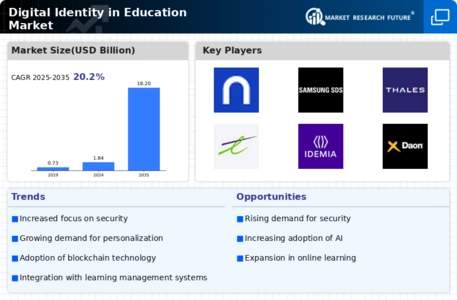Market Trends
Key Emerging Trends in the Digital Identity in Education market
The Digital Identity sector has become a key player in the rapidly changing education market by providing innovative solutions aimed at meeting the increasing need for secure identity verification. The competition in this industry is fierce, and to position themselves effectively in it, Digital Identity companies utilize various strategies for gaining market share. One of them is differentiation, which is where organizations highlight unique features or benefits that make them different from others. For instance, Digital Identity firms within the education space can distinguish themselves by offering seamless integration with educational platforms, high-security levels, and simple user interfaces. By emphasizing these special aspects, corporations can develop their niche markets and consequently appeal to clients who are after specific value propositions. Additionally, market penetration is another basic strategy. Digital Identity firms may focus on certain fragments of the education sector, such as online learning platforms, academic institutions, or certification programs. To gain a strong foothold within these specialized areas and increase their market shares there, these companies will need to tailor-make their innovations so that they can best satisfy their specific needs. Furthermore, innovation is very critical while jostling for a better market share position. It means that there are always new demands emerging in the field of education, hence calling for research and development investment by digital identity companies that seek to remain relevant in this kind of business (Bouckaert et al., 2018). By being ahead of technology developments as well as dynamic changes in safety issues, companies may appear among those who set trends in this sphere, attracting users who want cutting-edge identification techniques. Moreover, strategic partnerships offer great opportunities for positioning on market share. By cooperating with established educational technology providers, students' information systems, or industry associations, Dicas enhances its visibility and reputation across America's school system, especially universities. The benefit of such cooperation would be a wider customer base, thus establishing the company as an authoritative provider of authentication services. Thus, to achieve an effective positioning of the company on marketing shares, it should strive to put the customers at the core of its business operations. Companies in that line should be devoted to ensuring that clients are satisfied as they offer personalized guidance, all-inclusive training, and responsive customer support. This way, firms can develop strong ties with educational institutions as well as students, thereby becoming the preferred provider of identification help. Moreover, an effective marketing and communication strategy is indispensable. Thus, one may suggest that Dicas could use targeted advertising campaigns and take part in industry events to enhance its brand recognition and establish itself as a thought leader among education technology companies.


















Leave a Comment